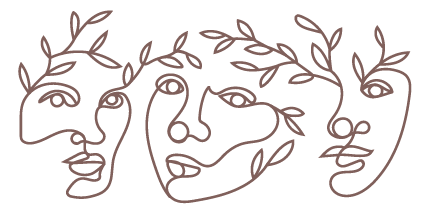White Walls—At What Cost?
Graphic by Breah Johnson
The page I’m typing this on is white. And empty except for a few words, and is frankly, ghastly (these empty pages are, of course, a shared dread). Symbolically, the color white has always stood for peace, purity, wisdom, among others. The Guardian, too, expresses this: “White is best for a fresh start. It’s a blank canvas, it’s a new page”. But is absence becoming what we wake up surrounded by everyday?
A lot of classrooms, stores, and homes are painted a plain, barren white (and off-white). In his book Colours: What They Can Do For You, Louis Cheskin reports “White walls, as we know, are an optical strain and a psychological hazard.” What makes white a detrimental color? The truth is, it represents how many people over time have come to live: with a lack of personal meaning, stuck on potential (opposed to action), and, of course, sterilization. Goals also differ: making a house look “expensive”, a waiting room peaceful, a classroom focused. Clearing the table of any “distractions” and downsizing is a consideration. However, are our definitions of these words skewing out of meaning and foundation?
Especially in classrooms, the abstraction of vividity and creativity raises the question: What are we downsizing on, exactly? Are we sure it’s not just (visual) stimulation mistaken for unnecessary distraction?
A PIBBS research poses the question: Once schools have achieved minimum structural conditions, do students have what they need to succeed? The research also talks about Symbolic Environment, bringing up things like wall decór—pictures of presidents and accomplished people on the walls, quotes, and images that direct our gaze to the future even through the periphery.
Taking this trajectory away by focusing on the immediate implications of the environment, like no “distractions”, “silence” and “focused” means taking away from the long-term, a stagnant state with no creativity, unfriendly. The use of white in institutional settings is ironic: it is aimed at maximizing potential, donating a clean slate, but it still represents over and over potential that is left unutilized; a foundation with no attempt to build it up. I know, for one, that when I think of school and the exhaustion that comes with, I think of echoes and a bright white classroom shrinking my pupils, white windows closed, barely any color except a dull brown shelf in a corner. There are only dull buzzing lights that bounce off the white walls. A bubble that is screened white, blocked, with no dialogue with the world outside—where you can’t tell where you’re going.
This abstraction of personality is seen in a lot of homes, as well, like with the “Scandinavian Minimalism” trend. This style outlines taupe colors and “functionality”, emphasizing storage space to get knick-knacks and distractions out of the way. The love and intimacy of a home, of comfort, is taken away and what’s left is a house, a vessel.
We have repeatedly seen how wellness and productivity both are improved upon among walls that offer color, some form of stimulation. Grangaard (1993, p. 99) puts it in perspective—drawing a line between nature and ourselves evolutionarily:
The efficacy of returning to environments more empathetic with our caveman subconscious; sunlight; clean, fresh air; the colors of the earth and sky, have proven to boost productivity in the private sector wherever it has been emphasized.
Colors play an often silenced but definite role in carving out our daily lives; moving away from that connection to color in the name of “focus” (despite evidence to the contrary) only goes against ourselves, our nature against monotony. We ought to realize that this oversaturation can turn blinding, not to mention the rich architectural history that may be lost by people eager to turn homes into minimalistic white-washed houses. Colors sit with us and hold us, and it only makes sense to peel down the white walls of the bubble to hold the world back and build upon our daily lives.

